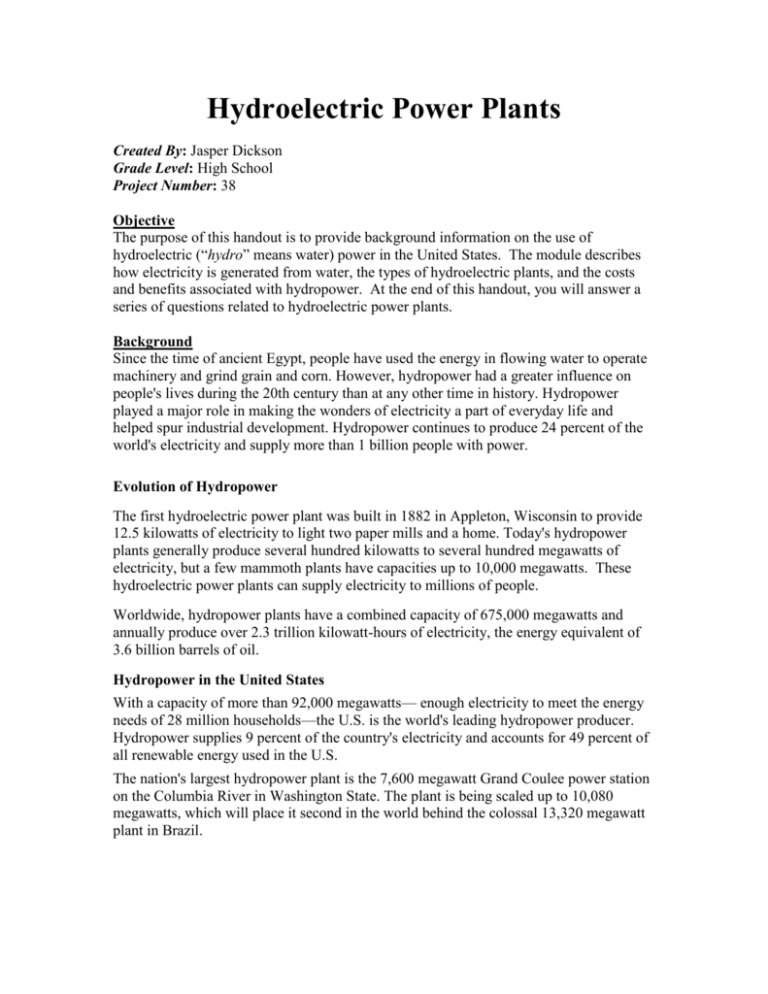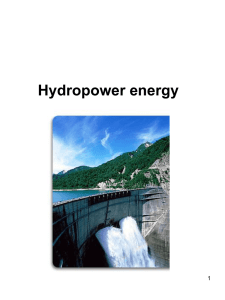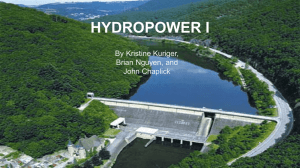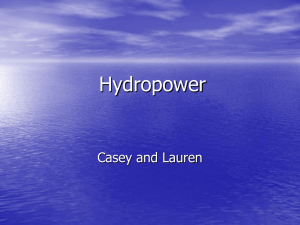Hydroelectric Power Plants
advertisement

Hydroelectric Power Plants Created By: Jasper Dickson Grade Level: High School Project Number: 38 Objective The purpose of this handout is to provide background information on the use of hydroelectric (“hydro” means water) power in the United States. The module describes how electricity is generated from water, the types of hydroelectric plants, and the costs and benefits associated with hydropower. At the end of this handout, you will answer a series of questions related to hydroelectric power plants. Background Since the time of ancient Egypt, people have used the energy in flowing water to operate machinery and grind grain and corn. However, hydropower had a greater influence on people's lives during the 20th century than at any other time in history. Hydropower played a major role in making the wonders of electricity a part of everyday life and helped spur industrial development. Hydropower continues to produce 24 percent of the world's electricity and supply more than 1 billion people with power. Evolution of Hydropower The first hydroelectric power plant was built in 1882 in Appleton, Wisconsin to provide 12.5 kilowatts of electricity to light two paper mills and a home. Today's hydropower plants generally produce several hundred kilowatts to several hundred megawatts of electricity, but a few mammoth plants have capacities up to 10,000 megawatts. These hydroelectric power plants can supply electricity to millions of people. Worldwide, hydropower plants have a combined capacity of 675,000 megawatts and annually produce over 2.3 trillion kilowatt-hours of electricity, the energy equivalent of 3.6 billion barrels of oil. Hydropower in the United States With a capacity of more than 92,000 megawatts— enough electricity to meet the energy needs of 28 million households—the U.S. is the world's leading hydropower producer. Hydropower supplies 9 percent of the country's electricity and accounts for 49 percent of all renewable energy used in the U.S. The nation's largest hydropower plant is the 7,600 megawatt Grand Coulee power station on the Columbia River in Washington State. The plant is being scaled up to 10,080 megawatts, which will place it second in the world behind the colossal 13,320 megawatt plant in Brazil. How Hydropower Works Hydropower converts the energy in flowing water into electricity. The quantity of electricity generated is determined by the volume of water flow and the amount of "head" (the height from turbines in the power plant to the water surface) created by the dam. The greater the flow and head, the more electricity produced. A typical hydropower plant includes a dam, reservoir, penstocks (pipes), a powerhouse and an electrical power substation. The dam stores water and creates the head; penstocks carry water from the reservoir to turbines inside the powerhouse; the water rotates the turbines, which drive generators that produce electricity. The electricity is then transmitted to a substation where transformers increase voltage to allow transmission to homes, businesses and factories. Types of Hydropower Plants Conventional Most hydropower plants are conventional in design, meaning they use one-way water flow to generate electricity. There are two categories of conventional plants, run-of-river and storage plants. Run-of-river plants—These plants use little, if any, stored water to provide water flow through the turbines. Although some plants store a day or week's worth of water, weather changes—especially seasonal changes—cause run-of-river plants to experience significant fluctuations in power output. Storage plants—These plants have enough storage capacity to off-set seasonal fluctuations in water flow and provide a constant supply of electricity throughout the year. Large dams can store several years worth of water. Pumped Storage In contrast to conventional hydropower plants, pumped storage plants reuse water. After water initially produces electricity, it flows from the turbines into a lower reservoir located below the dam. During off-peak hours (periods of low energy demand), some of the water is pumped into an upper reservoir and reused during periods of peak-demand. Building Hydropower Plants Most hydropower plants are built through federal or local agencies as part of a multipurpose project. In addition to generating electricity, dams and reservoirs provide flood control, water supply, irrigation, transportation, recreation and refuges for fish and birds. Private utilities also build hydropower plants, although not as many as government agencies. Benefits Hydropower is a clean, domestic and renewable source of energy. Hydropower plants provide inexpensive electricity and produce no pollution. And, unlike other energy sources such as fossil fuels, water is not destroyed during the production of electricity—it can be reused for other purposes. Obstacles Hydropower plants can significantly impact the surrounding area—reservoirs can cover towns, scenic locations and farmland, as well as affect fish and wildlife habitat. To mitigate impact on migration patterns and wildlife habitats, dams maintain a steady stream flow and can be designed or retrofitted with fish ladders and fishways to help fish migrate upstream to spawn. However, there are still other risks with the introduction of dams into the river systems. By introducing new water conditions such as a reservoir or a dam, a well-oxygenated river can turn into an anoxic lake (being devoid of oxygen). Also, the water stored behind dams tends to accumulate sediment and silt. This accumulation can hinder the water flow and cause harm to the turbines and pumps. As an example, after only four years of operation, the Sanmen George Dam on the Yellow River, China lost 41% of its water storage capacity and 75% of its maximum power capacity due to sedimentation. Potential The best sites for hydroelectric plants are swift-flowing rivers or steams, mountainous regions and areas with heavy rainfall. Only 20 percent of potential U.S. hydro-power has been developed, but unfavorable terrain and environmental concerns make many sites unsuitable for hydropower plants. However, since only 2,400 of the nation's 80,000 dams are currently used for hydropower, new projects do not necessarily require building new dams—many existing dams can be retrofitted to produce electricity. At existing hydropower plants, advanced technologies can be installed to increase efficiently and energy production. Questions 1. When and where was the first hydroelectric pump built? 2. Where is the largest hydropower plant in the U.S.? What is its power capacity? 3. Briefly describe how a hydroelectric pump works. 4. What are the types of hydropower plants? List the major characteristics for each type. 5. What are the benefits of hydroelectric plants? What are the drawbacks? List a specific example. 6. Using the hydropower map, list the states that use the most hydroelectric power in the United States.









